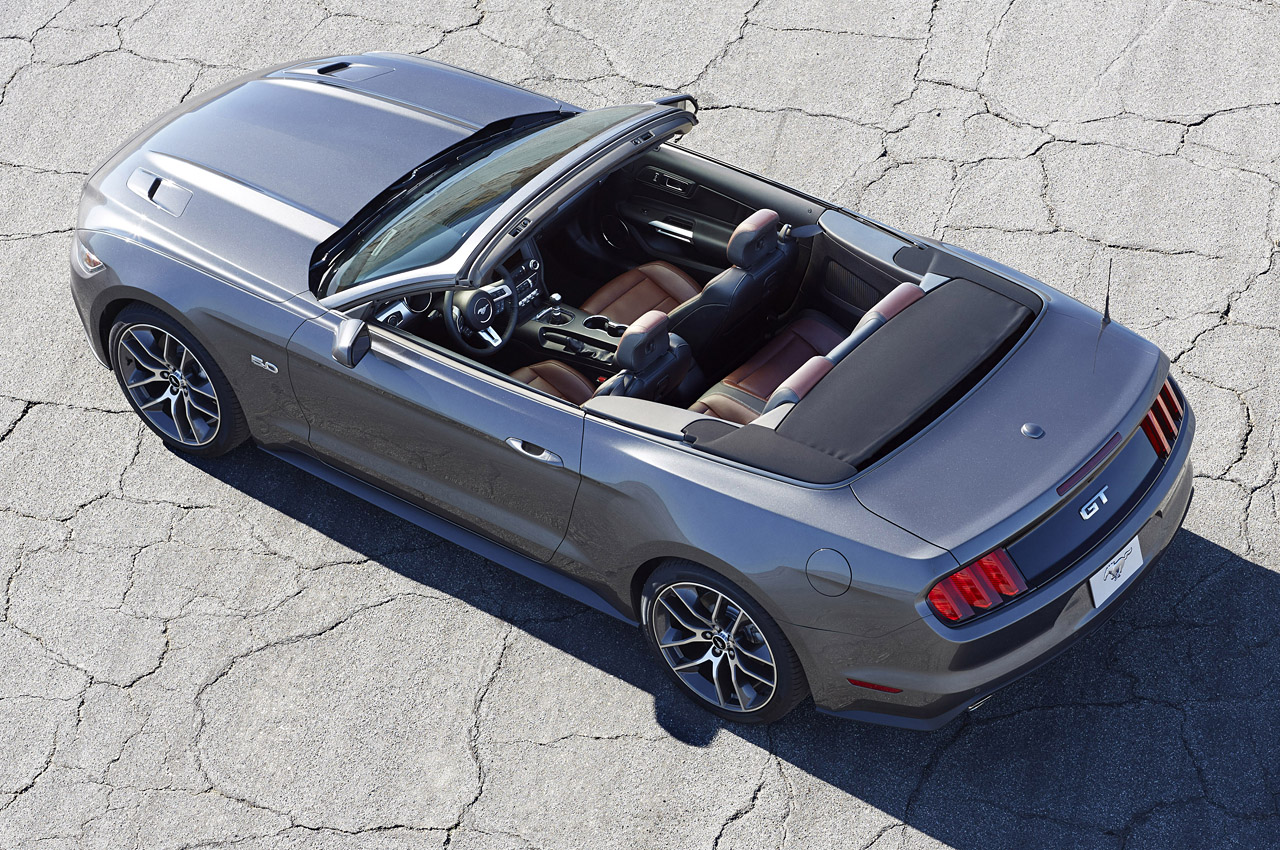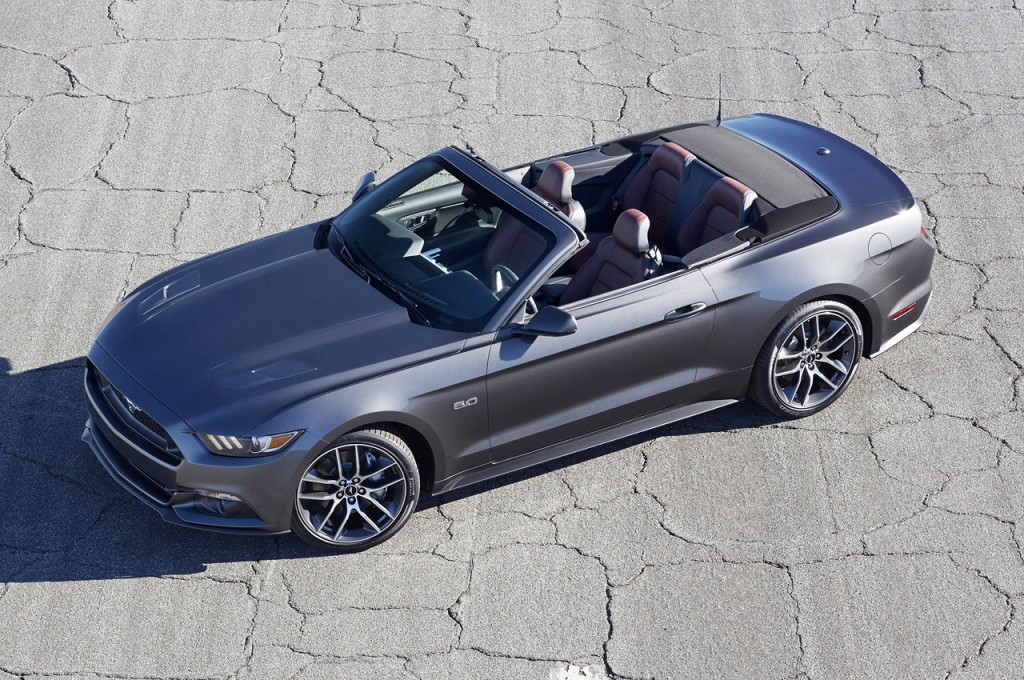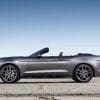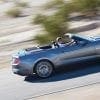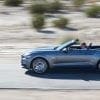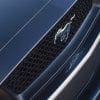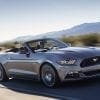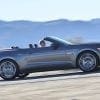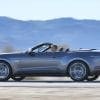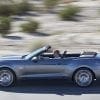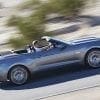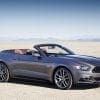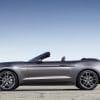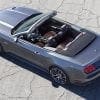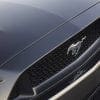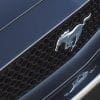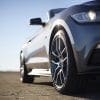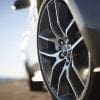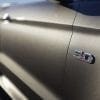Ford has released a bevy of new details and photos showing the 2015 Ford Mustang convertible in all its glory. The new Mustang convertible has been completely redesigned with new features sure to catch your eye and aid in your enjoyment of the outdoors.
New for the 2015 Mustang convertible is a electromechanical drive and single-handle center latch which helps the top lower in half the time of the current model. The convertible top comes standard with a fabric outer layer and is fully lined and insulated for a quieter ride. Also improving on the convertible model is the trunk space due to a more compact roof and the addition of independent suspension which contributes to segment-leading space.
Check out the photos and more details below in the press release.
Press Release:
Designed from the wheels up to deliver maximum droptop enjoyment, the all-new Ford Mustang convertible is a fantastic way to escape the daily grind of life and hit the open road. With its distinct style and a completely redesigned top system, drivers can enjoy the shining sun or sparkling stars quicker with all of the performance and character expected of Mustang.
“Convertible tops and iconic sports cars like Mustang have always been a great pairing,” said Dave Pericak, Mustang chief engineer. “This is the best convertible we’ve ever built with a one-of-a-kind design that is instantly recognizable as Mustang and an outstanding all-around driving experience.”
Creating the new Mustang convertible involved far more than just slicing the top off the fastback. The two cars were designed and engineered from the ground up, incorporating an array of visually subtle, but important, changes to make sure each stood on its own while meeting increased standards of quality, performance and refinement.
“From the start, we committed to giving Mustang convertible a unique look from the fastback with the clean, cohesive design it deserved ,” said Joel Piaskowski, exterior design director.
“From the raised and straightened muscle line on the rear haunches to the recontoured trunklid, the new Mustang convertible has a more linear quality whether the top is up or down, giving the car its own distinct presence on the road.”
For the first time on Mustang, every convertible roof gets a full fabric outer layer for the roof plus a full inner headliner to enclose the five-bow structure. Sandwiched in between these layers is a full 10-millimeter thick insulation pad that makes the convertible nearly as quiet inside with the top up as the fastback.
“A great deal of effort went into details such as the shape of the rear quarter windows so that they could drop completely out of sight when the top is down,” said Piaskowski. “The top system was carefully refined to prevent unsightly folds or ‘ears’ at the rear corners of the roof when it’s up.”
Lowering the roof is easier than ever. A new center-mounted single latch offers quick one-handed operation right from the driver’s seat. The new electromechanical drive system raises or lowers the roof in half the time required previously with just a press of a button on the center console. The electric drive system is also much quieter than the previous electro-hydraulic design.
“When you’re sitting in the driveway or at a traffic light and you decide you want to enjoy some sunshine, you shouldn’t have to wait around for the top to lower,” said Pericak. “Our team worked to engineer a retractable roof that gets out of the way or closes up quickly and quietly.”
The combination of a more compact mechanism and lower beltline for the new Mustang means the Z-fold roof is flatter and tucked further out of the way than before. The highest point of the folded stack is now 6.7 inches lower than the outgoing Mustang, contributing to the sleeker and more sophisticated looking profile and better rear visibility for the driver.
A well-engineered top and dramatically upgraded cabin are just part of making a great convertible sports car. Like the fastback, Mustang convertible features significantly increased use of high-strength and ultra-high-strength steels throughout the body structure.
Torsional stiffness of the convertible body has been increased by 13 percent to produce a more stable platform to better take advantage of the new fully independent suspension. The result is more refined ride quality over any road surface and significantly improved handling when pressed into the curves.
Mustang convertible inspires drivers to put the top down and hit the road, so having usable cargo space is a big plus. The more compact roof and flat load floor enabled by the new suspension boost trunk volume by 19 percent to a class-leading 11.4 cubic feet, big enough to swallow two large golf bags, even with the available premium audio subwoofer. The lower liftover height also makes it easier load up the trunk.
For 50 years, Mustang has combined sports-car performance with the ability to bring some friends along for the ride, and the new convertible makes this even easier. The wider rear of the new Mustang and the new top design contribute to more shoulder and hip room for rear-seat passengers.
More Aerodynamic Testing Helps the All-New Ford Mustang Slice Through the Air Efficiently and Stay Planted
- All-new Ford Mustang features a sleek, modern and muscular interpretation of the iconic pony car form that is more aerodynamically efficient
- Mustang is first Ford with front-wheel aero curtains that help guide airflow across the front wheels
- Careful shaping of Mustang’s front and rear help to keep the car planted on the road for more confident handling and steering at higher speeds
The bold, muscular form of the all-new Ford Mustang reimagines the iconic sports car shape in a way that retains the character that fans expect from the brand while incorporating aerodynamic technology that improves fuel efficiency and performance.
“Even with the classic, forward-leaning shark-bite grille and a more aggressive stance for the new Mustang, the aerodynamics team has made it slice through the air better for increased fuel efficiency while also keeping it planted to the road at higher speeds,” said Dave Pericak, Mustang chief engineer. “The best part is that they met the challenge of creating the sleekest Mustang yet without resorting to a characterless teardrop shape.”
Design and performance are two of the essential attributes that have made Mustang appeal to millions of fans for five decades. Performance can be improved by increasing the output of the powerplant or reducing the amount of work it has to do. The new Mustang is doing both with improved powertrains and a sleeker shape that slips through the air with less effort.
Aerodynamics plays an increasingly important role in overall vehicle performance as speed increases. The force required to slice through the air goes up exponentially with the speed, so twice the speed requires eight times the horsepower just to overcome drag. That means small changes can have a big impact on both performance and fuel efficiency.
“With the new Mustang, we spent about twice as much time running aerodynamic simulations and doing wind tunnel tests than the previous Mustang,” said Carl Widmann, aerodynamics engineering manager. “Major advances in our computational fluid dynamics capability let us test the effect of design changes and give feedback to the studio in less than 48 hours so they had more opportunity to try out different styling ideas.”
Using air to manage airflow
It’s not visually obvious, but rotating wheels are a major source of aerodynamic drag. However, enclosing the wheels in skirts to smooth the flow just doesn’t look right, especially on a performance car like Mustang. Widmann and the aerodynamics team adopted a different approach for Mustang, giving it the first Ford application of wheel aero curtains.
Vertical slots in the outer edge of the front fascia channel air from the front of the car to openings in the wheel wells, directing it across the outer surface of the wheel and tire. The wall of high-speed air works much like a skirt to reduce drag while still leaving the beautifully designed alloy wheels fully exposed.
Managing temperatures
In addition to helping define the visual identity of a car like Mustang, the grille also has to provide an inlet for air that cools the engine. Allowing air to flow through the engine bay instead of directing it around the sides and over the top of the body increases drag. Each of Mustang’s three available engines gets a unique grille that allows in only as much air as that powerplant needs.
Active grille shutters will help make Mustang powered by the new 2.3-liter EcoBoost® engine even more fuel efficient by further reducing drag at higher speeds when extra cooling capacity is not needed. The shutters can completely close off the grille, sending air over and around the car instead of through the engine compartment. Even the ribs that make up the mesh in the grille have been carefully shaped to reduce air resistance and wind noise.
Keeping the car planted
With a top speed of 155 mph for the V8-powered Mustang GT, ensuring confident and precise handling is crucial. New Mustangs are equipped with splitters and air dams below the front fascia that help to minimize air under the car. Mustang GT also features a pair of vents in the hood that also contribute to keeping the front-end planted on the road.
“We worked closely with the vehicle dynamics engineers that are tuning the chassis to make sure our experimental results for lift correspond to what they feel on the car when driving at the track,” said Widmann. “They provided us with some great feedback that we incorporated into our efforts in the tunnel, and the results are definitely noticeable when driving at high speeds.”
The overall air resistance is a combination of the frontal area and drag coefficient. Despite the wider rear haunches, the lower roofline contributes to a smaller frontal area. Along with a lower drag coefficient, the overall drag force of the new Mustang is slashed by an impressive 3 percent with better roadholding and less wind noise in the cabin. At highway speeds, three percent less drag will return about one percent better fuel efficiency.
Source: [Ford]


